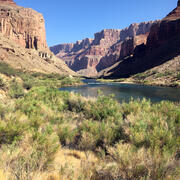Native Fishes
Native Fishes
Filter Total Items: 16
Providing Unbiased Actionable Science & Information to Meet National Resource Management Needs of the U.S.
The U.S. Geological Survey Southwest Biological Science Center (SBSC) is uniquely positioned to provide sound information, specialized expertise, and innovative tools to support the management and sustained use of natural resources on public and Tribal lands in the Southwest U.S.
Vegetation monitoring: How one square meter can tell the story of 255 river miles along the Colorado River
The goal of SBSC's Grand Canyon Monitoring and Research Center’s (GCMRC) riparian vegetation monitoring program is to assess changes and trends in plant species composition and cover and relate those changes to river hydrology, climate, geomorphology, and the operations of Glen Canyon Dam.
Riparian Vegetation in Grand Canyon: An Overview
Riparian plant communities, associated with rivers and streams, are ecologically and culturally important areas in the southwestern U.S. Despite covering less than 2% of the land area in the southwest, the resources provided by these communities make them valuable to wildlife, the public, scientists, and resource managers.
Study Uncovers Migration Patterns of Native Fish in the Colorado River
A study conducted by the USGS provides new insights into the migration patterns of three native fish species in the Colorado River: humpback chub, flannelmouth sucker, and bluehead sucker. This research highlights the importance of understanding native fish population dynamics within the Colorado River ecosystem in Grand Canyon, AZ.
Colorado River Basin Science
The Grand Canyon Monitoring and Research Center, a branch of the Southwest Biological Science Center, conducts scientific assessments of the Colorado River in Grand Canyon, focused primarily on Lake Powell and the river ecosystem downstream of Glen Canyon Dam. On this page, we'd like to share related interactive tools and projects by other USGS Centers that cover science across the upper and lower...
Humpback Chub in the Colorado River, Grand Canyon
Threatened humpback chub are a native fish found only in the Colorado River Basin. Once found in warm-water canyons in the Basin, the largest population now persists in the Colorado River in Grand Canyon National Park, downstream of Glen Canyon Dam and Lake Powell, the reservoir upstream, created by the dam.
Partners in Science
Partners in Science is a collaborative effort between Grand Canyon Monitoring and Research Center, Grand Canyon Youth, and the National Park Service to provide opportunities for youth to engage in scientific field research in Grand Canyon. This partnership connects youth from diverse backgrounds with the Nation’s natural and cultural resources on 2-3 river-based expeditions on the Colorado River...
SBSC Tribal Partnerships
The Southwest Biological Science Center (SBSC) conducts and provides scientific information as part of our mission and Federal Trust Responsibility to strengthen relationships and build partnerships with sovereign tribal nations. Here, we highlight a few examples of projects with tribal partners.
Rainbow Trout in the Colorado River, Grand Canyon
Rainbow trout are a desirable sport fish that have been introduced in many locations around the world, including the Colorado River. Although introductions of rainbow trout and other nonnative fishes provide recreational fishing opportunities, they can also pose threats to native fish populations. The Glen Canyon Dam Adaptive Management Program has tasked scientists and managers with identifying...
GCMRC Science Informs Hydropower and Invasive Species Management
USGS Southwest Biological Science Center's Grand Canyon Monitoring and Research Center provided scientific expertise to evaluate potential effects of reservoir management on various resources in Lake Powell and Grand Canyon. This information, published in a cooperator report, was requested and used by the Bureau of Reclamation for decision-making on water flows from Glen Canyon Dam.
Grand Canyon Monitoring and Research Projects
The Grand Canyon Monitoring and Research Center currently functions under a Triennial Work Plan (TWP) which is thoroughly reviewed and vetted both internally within the Center and through the GCDAMP Technical Work Group (TWG) and the Adaptive Management Work Group (AMWG). These advisory panels have been a part of the Glen Canyon Dam adaptive management process since the inception of the GCDAMP...
Uncovering the Base of the Food Web: Primary Production Dynamics in the Colorado River
Algae, phytoplankton, and rooted macrophytes represent the base of many aquatic food webs and are known as primary producers. Through photosynthesis, these organisms convert sunlight energy into chemical energy (i.e., carbon) that in turn fuels the growth of animals such as macroinvertebrates and fish. This project uses high frequency measurements of dissolved oxygen, which is a by-product of...












